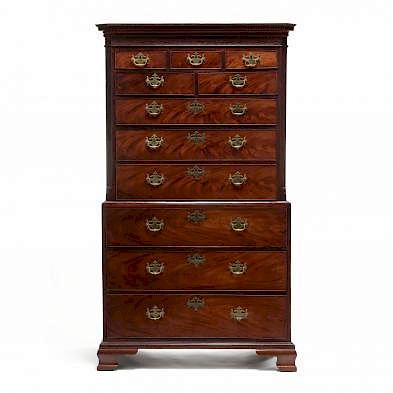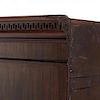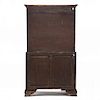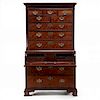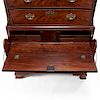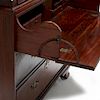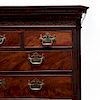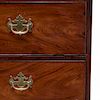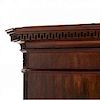Important Charleston South Carolina Double Chest of Drawers
Two ways to bid:
- Leave a max absentee bid and the platform will bid on your behalf up to your maximum bid during the live auction.
- Bid live during the auction and your bids will be submitted real-time to the auctioneer.
Bid Increments
| Price | Bid Increment |
|---|---|
| $0 | $25 |
| $500 | $50 |
| $1,000 | $100 |
| $3,000 | $200 |
| $5,000 | $500 |
| $10,000 | $1,000 |
About Auction
Dec 2, 2016 - Dec 3, 2016
Leland Little Auctions info@lelandlittle.com
- Lot Description
circa 1760 -1770s, mahogany veneers with solid mahogany below the drawer fronts, bald cypress secondary wood, two part form with a desk drawer. The dovetailed upper case has a stepped cove-molded cornice above an applied Doric dentil molding (loss of one tooth to rt. side) above a carved applied figure-eight fretwork frieze, three over two over three cock-beaded drawers, each with full dust boards, are flanked by stop fluted quarter columns.
The dove-tailed lower case has applied molding on three sides over a pull-out desk drawer with original cyma sides, but with loss to the original interior, the cock-beaded drawers have 3/4 dust boards, raised on original ogee bracket feet. A wood identification report from Alden Identification Service accompanies lot.
76.75 x WOA 44.5 x 25 in. Case depth 22.75 in. and case width 40 in.
Featured in the following publication:
Bradford L. Rauschenberg, John Bivins, Jr., The Furniture of Charleston, 1680-1820, Volume I: Colonial Furniture, (The Museum of Early Southern Decorative Arts, Winston-Salem, 2003), p. 146, Fig. CC-32, MESDA Reference File: 28,780.
From the estate of Wilmot and Charles Haskell Gibbs of Charleston, SC. Consignor's paternal grandmother was Anne Simmons Ball Gibbs (1880-1946), daughter of Anne Hume Simons Ball (1857-1914) and John Coming Ball (1848-1926). Descendants of Benjamin Simmons (d.1772), who built Middleburg Plantation in Berkeley County, the oldest wooden plantation still standing in South Carolina, the chest has descended in the family to the consignor. While listed as having descended through the Hall family in the Biven's literature, the correct listing of the family is Ball. Additional genealogy is available at the Gallery.Condition
Upper Case: the fretwork frieze has been moved from the sides to the front due to a later pediment added, now replaced with a proper front cornice.
Chips and losses upper right cornice; center upper drawer has a patch above the lock, lacking lock; the second row left drawer has a corner patch; upper two rows of drawers with patches from earlier pulls; uppermost long drawer has cut and patch below one pull; all runners replaced; drawer guides replaced while retaining most of the original stops. Lower Case: has no pull patches; scattered small patches and cock-beading repairs throughout; hairline to rear right foot; rear foot braces replaced.
All brass pulls replaced; back boards have later nails amongst original wrought nails; the upper full length back board had been previously removed, and if again removed, would reveal a cavity behind the frieze. - Shipping Info
-
SHIPPINGOur Shipping Department is pleased to handle the shipping of wine (including international wine shipment), and domestic shipping of jewelry, silver and coins.Each item shipped in-house is carefully wrapped and double boxed with the appropriate packing materials, following carrier guidelines, to provide safety in transit. There is a minimum shipping and handling charge of $25. In an effort to provide complete confidence and satisfaction in your delivery, all in-house shipments are shipped with their declared value and full insurance per the carrier's terms and conditions. A signature is required for delivery.Please be advised that LLA, Ltd. does not automatically ship items. If shipping arrangements cannot be completed online, please email the Shipping Department to request a quote. We will respond to your request in the order in which in was received. Please include the invoice number (if available), lot numbers, the correct shipping address and postal code with your request. Shipping quotes are valid for 15 days. Our Shipping Department is small in scale; shipping may take several weeks from the time of initial contact.All items other than wine, jewelry, silver and coins, items needing expedited shipping, or items requiring international shipping, will require a third party shipping vendor. Choosing a third party shipping vendor requires that you complete our Shipping Release Form, which is available online. This form authorizes us to release your purchased items to another party. We will not release your lots to any shipper or third party until we have received this form and payment has been made in full.Please note that for all shipments leaving our in-house shipping department, any and all additional charges, including but not limited to customs charges, are the sole responsibility of the buyer. If you reside in a state or country that has import restrictions or regulations, it is your responsibility to obtain appropriate licenses to ship your purchased items, such as wine or any restricted materials (see the restricted materials section for more detail).Most of the wine sold at auction can be shipped in-house. Wine is shipped on Monday and Tuesday of each week to minimize weekend transit time. To prevent damage to wine from extended exposure to extreme temperatures, our Wine Director does not recommend shipment during warm weather months. Wine may be stored free of charge in climate controlled conditions for later shipment during cooler temperatures.LLA, Ltd. complies with all applicable laws and carrier regulations regarding the shipment of wine. If shipping wine, buyer warrants that he/she is at least 21 years of age. Buyer shall be responsible for the shipment of these wines to be received and signed for by an adult at least 21 years of age.By shipping in-house you are giving LLA, Ltd. permission to charge your provided credit card for said charges. All packing, handling, shipping, and delivery services are performed at the sole risk of the buyer. LLA, Ltd. assumes no legal or financial responsibility and is free from all liability associated with fulfilling your shipping request.
-
- Buyer's Premium



 EUR
EUR CAD
CAD AUD
AUD GBP
GBP MXN
MXN HKD
HKD CNY
CNY MYR
MYR SEK
SEK SGD
SGD CHF
CHF THB
THB